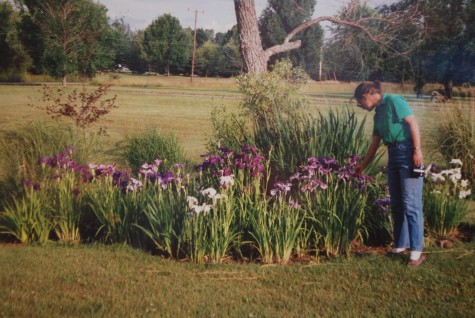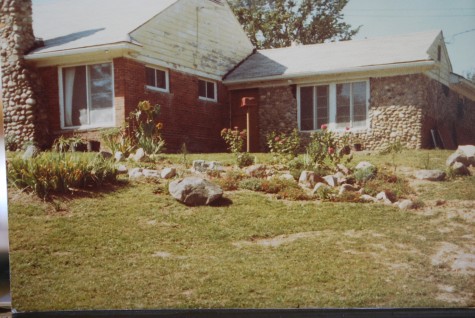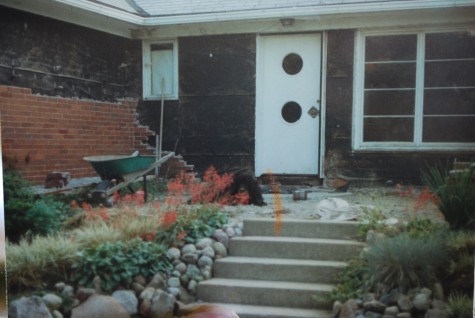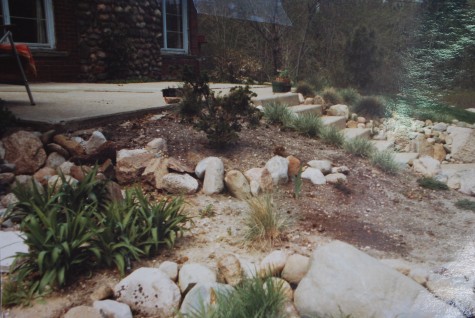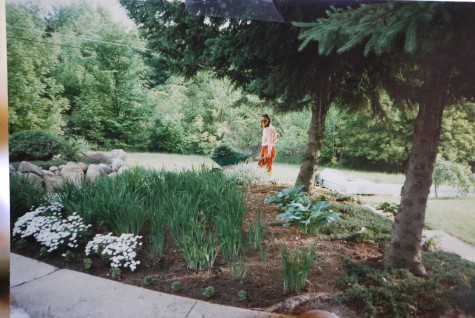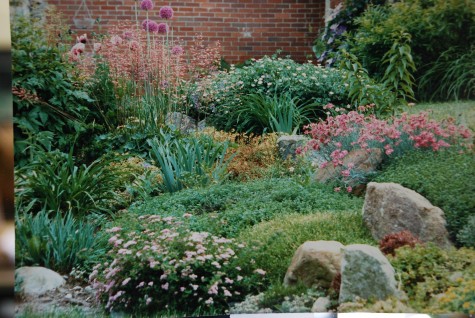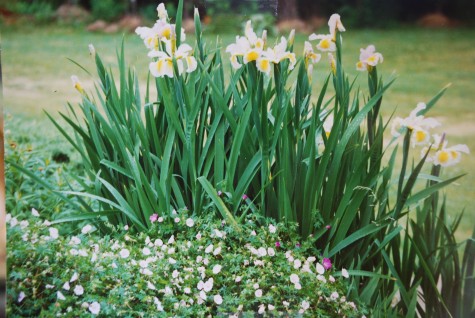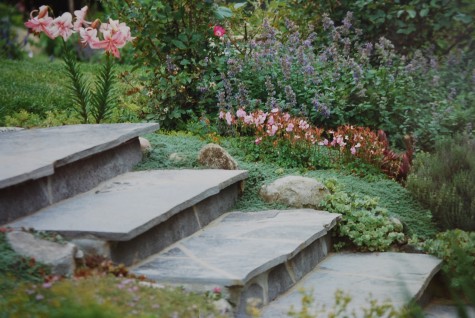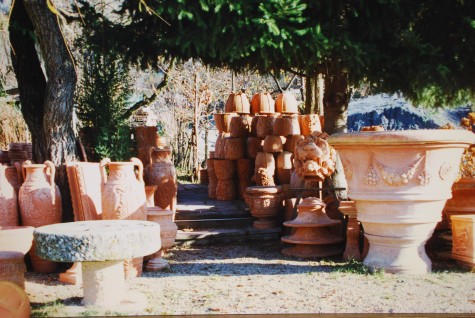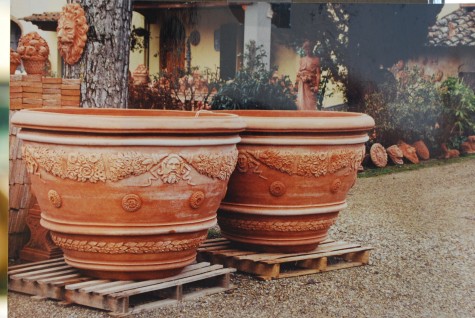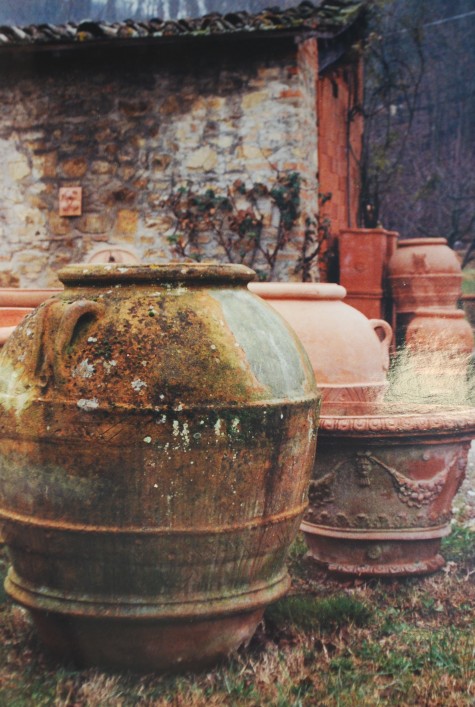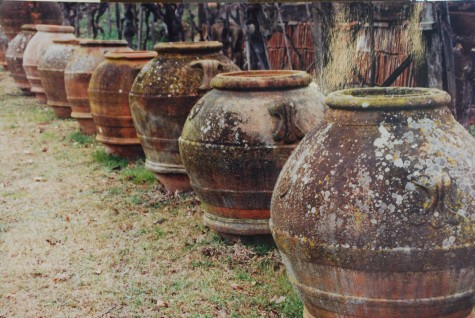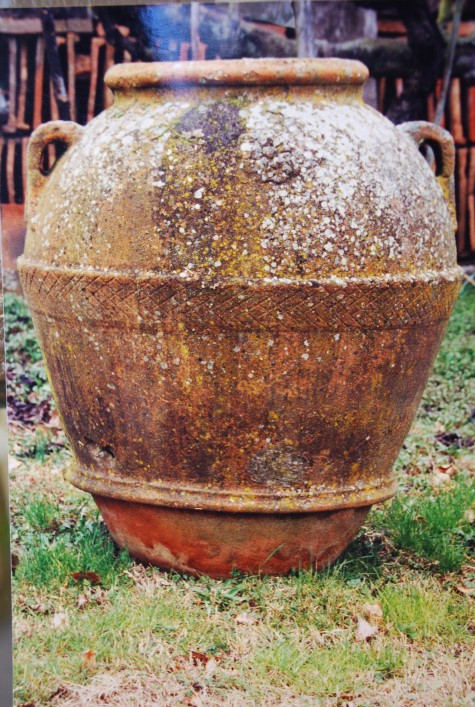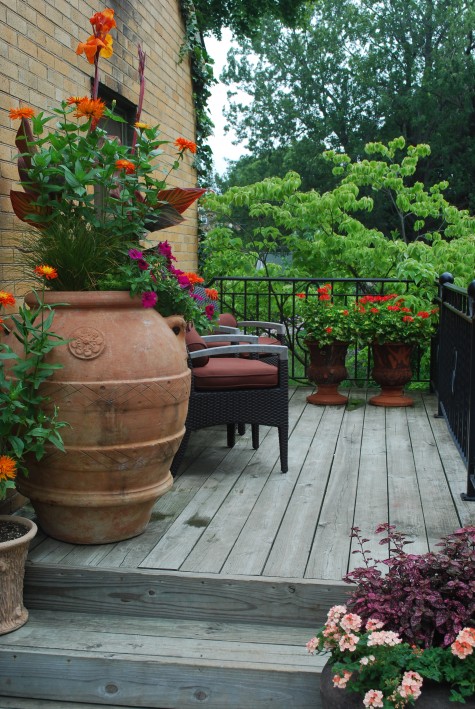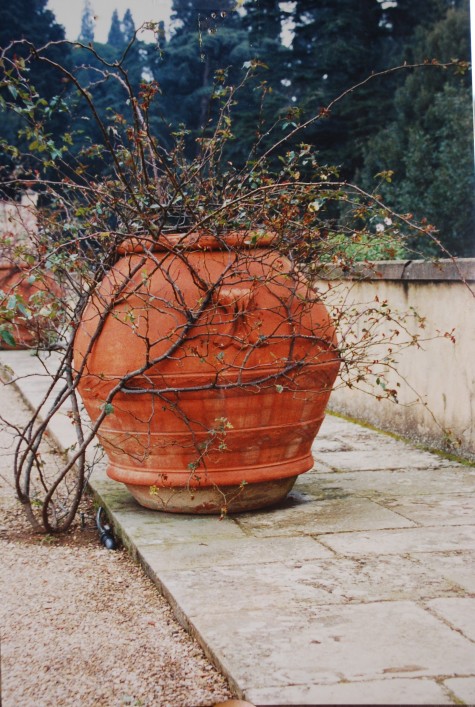
My first driveway-a 400 foot long ribbon of dirt. As I bought the house in October, I did not understand what that would mean in April after an inch or two of rain. But only once did the man across the street need to come haul my car out of the mud with his Ford tractor. Rough-everything about the property was neglected. I could work all weekend, and hardly spot what I did. But eventually the property did begin to work and look better.
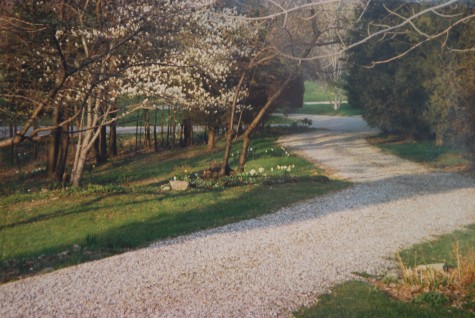 The day I was able to buy gravel for the drive was a good day. I did a half-baked job of grading it with my lawn tractor and a drag bar; I went on to persuade the gravel hauler to drop half his load every so many yards. I don’t remember my aching arms-I only remember how thrilled I was to have a real driveway.
The day I was able to buy gravel for the drive was a good day. I did a half-baked job of grading it with my lawn tractor and a drag bar; I went on to persuade the gravel hauler to drop half his load every so many yards. I don’t remember my aching arms-I only remember how thrilled I was to have a real driveway.
My lot was 300 feet in width, and over 900 feet deep. In the midsection-a low spot that collected water. Good horticulture had finally begun to influence where I planted things. My first choice for that wet spot-a 3 foot tall larch in a five gallon bucket. It grew like a weed, as did the spartina pectinata aurea marginata. Prairie cord grass loves marshy places, and will spread vigorously. I was fine with that-I had lots of room. It has a gracefully droopy look. The star of the bed-a collection of Japanese iris, backed up by a stand of yellow flag iris. The tree in the background was dead, but plenty of bird species nested in it. I kept it until the wind blew it over in a storm. I would learn that Japanese iris like wet during their growth period, but a gradual drying off and good winter drainage. I would move them three times before I got it right.
Gradually I added arborvitae, hoping to screen the road from view, and a single metasequoia set in the lawn to the left of the spartina grass. Planted in that low lying ditch of a spot, it grew incredibly fast. I bought it for a song; for whatever reason, the leader had died back. It was a park grade tree-meaning it was useful in a landscape where it would look fine, viewed from far away. It promptly developed a pair of leaders from the side-I rather liked that two-pronged look. Even up close.
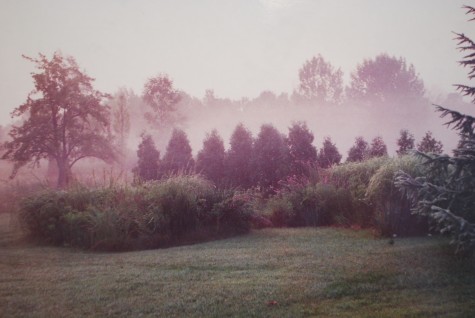 There were not so many plant species here, just lots of a few things. The bed finally got large enough to make a little statement from my bedroom window. The larch pictured on the right-a cultivar with distinctly blue cast.
There were not so many plant species here, just lots of a few things. The bed finally got large enough to make a little statement from my bedroom window. The larch pictured on the right-a cultivar with distinctly blue cast.
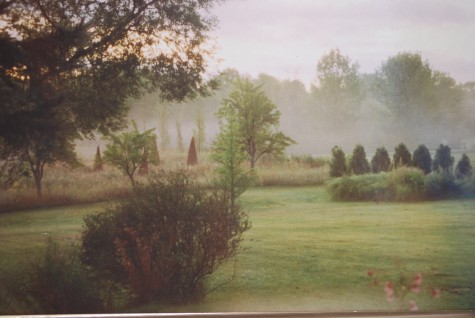 The part of my property closest to the road was home to an orchard at one time. Many of the properties in this neighborhood had old fruit trees-it must have been a very large orchard at one time. Three rows of apple trees, an intermediary swath of weeds, and one row of pears were all that remained. I liked these remains. Cutting the grass around the trees involved a wild ride on the mower. The ground was very uneven, and there were rocks that would pop up every spring in new places. I finally decided a meadow would be in order. I think I was beginning to really think about landscape here. It became a substantial feature of my garden-by virtue of what I did not do. A giant unmowed area can make a big statement.
The part of my property closest to the road was home to an orchard at one time. Many of the properties in this neighborhood had old fruit trees-it must have been a very large orchard at one time. Three rows of apple trees, an intermediary swath of weeds, and one row of pears were all that remained. I liked these remains. Cutting the grass around the trees involved a wild ride on the mower. The ground was very uneven, and there were rocks that would pop up every spring in new places. I finally decided a meadow would be in order. I think I was beginning to really think about landscape here. It became a substantial feature of my garden-by virtue of what I did not do. A giant unmowed area can make a big statement.
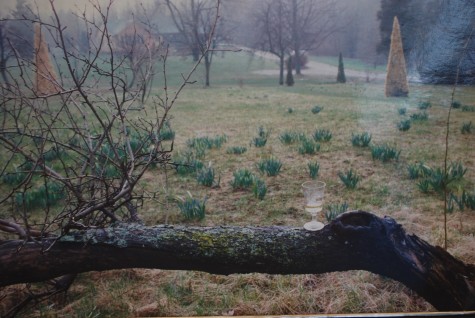 All I planted into it were as many daffodils as I could spring for every fall. I bought many a daffodil just before Thanksgiving for 10 cents each. I owned this property 15 years. My goal was to plant 1000 daffodils every year; I think I came close to that. I would rough cut the meadow once a year in the very late fall, or the very early spring. Never have I had a garden that gave so much pleasure with so little work as this one. The four-sided brown pyramids you see? I built the pyramids out of exterior grade plywood, and stapled cut boxwood to them for a client. Once she was done with them, she gave them back to me. I think the brown boxwood stems and leaves held on for at least 4 years after I placed them in the meadow. They were my first garden sculptures.
All I planted into it were as many daffodils as I could spring for every fall. I bought many a daffodil just before Thanksgiving for 10 cents each. I owned this property 15 years. My goal was to plant 1000 daffodils every year; I think I came close to that. I would rough cut the meadow once a year in the very late fall, or the very early spring. Never have I had a garden that gave so much pleasure with so little work as this one. The four-sided brown pyramids you see? I built the pyramids out of exterior grade plywood, and stapled cut boxwood to them for a client. Once she was done with them, she gave them back to me. I think the brown boxwood stems and leaves held on for at least 4 years after I placed them in the meadow. They were my first garden sculptures.
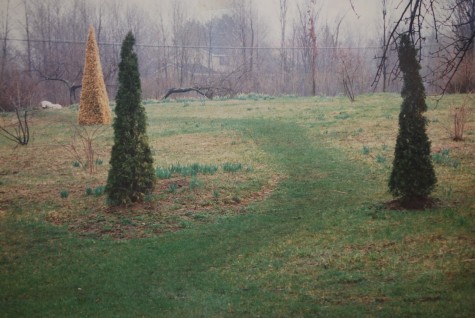 I no longer remember what these vertical evergreens were, but they marked the entrance to the meadow. I mowed a path through it, so I could walk the garden whenever I wanted. I invariably went this way to the mailbox, and then back up the drive past the wild garden. I eventually planted some species roses in this garden. Rosa Complicata is one of my favorites. Rosa Canina did well for me as well. Rosa glauca (in those days rose rubrifolia) and rosa seticera-I grew these too. I did nothing to care for them-they seemed to thrive. In the far top left of the picture, a very old marble sculpture of a torso of a lion-a gift from Al Goldner, a landscape designer and mentor whom I greatly admired.
I no longer remember what these vertical evergreens were, but they marked the entrance to the meadow. I mowed a path through it, so I could walk the garden whenever I wanted. I invariably went this way to the mailbox, and then back up the drive past the wild garden. I eventually planted some species roses in this garden. Rosa Complicata is one of my favorites. Rosa Canina did well for me as well. Rosa glauca (in those days rose rubrifolia) and rosa seticera-I grew these too. I did nothing to care for them-they seemed to thrive. In the far top left of the picture, a very old marble sculpture of a torso of a lion-a gift from Al Goldner, a landscape designer and mentor whom I greatly admired.
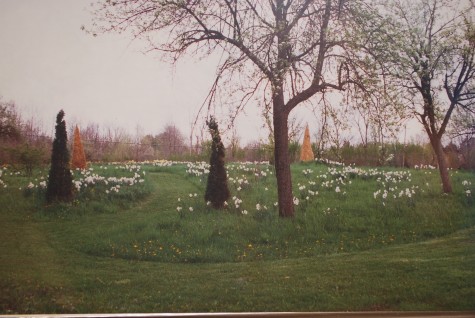 The daffodils were beautiful in the spring, as were all the meadow plants coming out of the ground so green and so lusty. The quack grass was rampant, but it did not deter the queen anne’s lace, and the asters. There would be a point in the summer when the entire meadow was a haze of lavender and purple.
The daffodils were beautiful in the spring, as were all the meadow plants coming out of the ground so green and so lusty. The quack grass was rampant, but it did not deter the queen anne’s lace, and the asters. There would be a point in the summer when the entire meadow was a haze of lavender and purple.
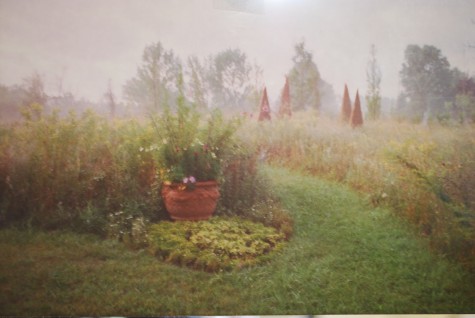 This pot from Italy-my first, in 1993. I eventually did sell it to a client whom I felt wanted it even more than I did-I couldn’t say no. But while it was there, I hauled water in a five gallon bucket all the way out there almost every day to keep that pot planting going.
This pot from Italy-my first, in 1993. I eventually did sell it to a client whom I felt wanted it even more than I did-I couldn’t say no. But while it was there, I hauled water in a five gallon bucket all the way out there almost every day to keep that pot planting going.

Though I knew but a little something about horticulture, and but a little something about composition, this picture really pleases me. I had an idea to grow plants, and create landscapes. I was having the time of my life.
